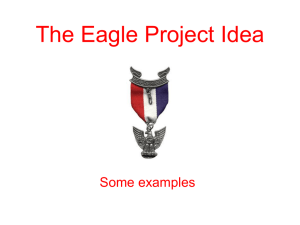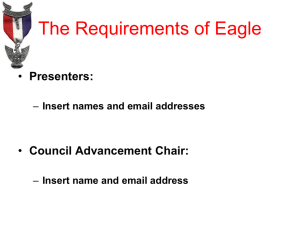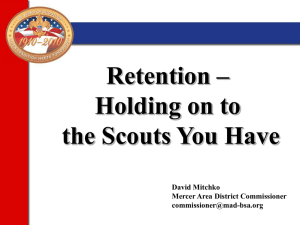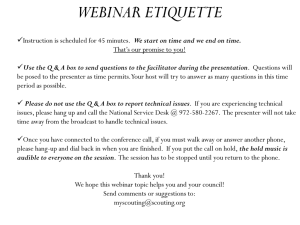How to Fill Out an Eagle Project Workbook
advertisement
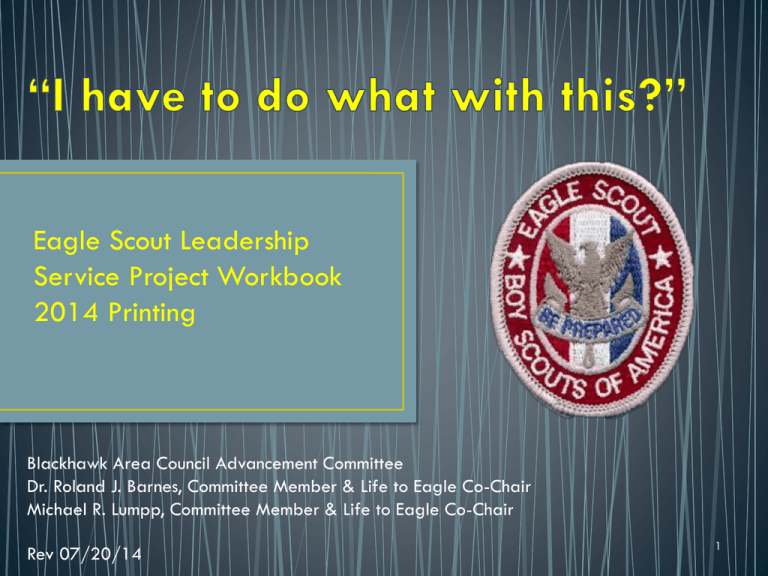
Eagle Scout Leadership Service Project Workbook 2014 Printing Blackhawk Area Council Advancement Committee Dr. Roland J. Barnes, Committee Member & Life to Eagle Co-Chair Michael R. Lumpp, Committee Member & Life to Eagle Co-Chair Rev 07/20/14 1 • • • • • • • There was a Scout young and simple. Then he grew up. When he was young he was eager to learn. Now he can’t wait to tell you what to do. In the last encounter we can get even. We hand him the Eagle Service Project Workbook. There was silence; and confusion swept over the face. And we saw that it was good. 2 • Don’t forget the help of your Scoutmaster, Life to Eagle Coordinator, and Advancement Chair. Speak to all of them. • Pick an Eagle Coach from your unit, your district, or your council to aid and guide you in the planning of your project. Preferably with expertise in the area that your project is concentrated. • This individual becomes your safety net throughout the process. Do not be afraid to use him/her. • We at council also stand behind you to serve your unit and you. If your unit or you have need of us we are only a phone call away. • Read everything before doing anything! 3 Remember Scouting is fun with a purpose. It is an adventure. Like so many things getting them started is the hardest step. Out of fear and doubt comes courage and determination. The final metamorphosis begins. If it was easy everyone would be doing it. That’s why roughly 4 out of every 100 are still standing when they close this workbook. Now for those who dare, let’s open it. 4 As you begin Mr. Brock asks that you consider the meaning behind the Life patch that you now wear. Not only does it represent health and fitness but it also stands for the spirit of caring and giving that’s behind the Eagle Scout service project. Service to other people is what Scouting is all about. 5 This workbook can only be downloaded online. Please use the following link: http://www.scouting.org/scoutsource/ BoyScouts/AdvancementsandAwards/ resources.aspx. If need be it can also be obtained from your local council service center. Remember to download the latest revision of item #512-927. The workbook includes four forms: a proposal, a final plan, a fundraising application, and a project report. 6 At the top appears the definition of requirement 5 as it appears on the Eagle Scout Application. The purpose of an Eagle Project is to develop leadership by providing service; “to help other people at all times.” Choosing a project to benefit any religious institution, any school, or your community including the “community of the world.” Watch for the restrictions at the bottom of the page. No changes are authorized to the workbook! 7 National asks that the Scout and his parents or guardians review this information. This page indicates that the information concerning the Eagle Scout service project is the same provided to everyone involved. This serves to level the playing field and ensures that all the requirements are applied fairly to all Scouts. National also provides a heads up on what a Scout should expect as he goes through this process. The responsibility for success belongs to the Scout and the final evaluation is left to the Board of Review. 8 This information is provided by National to address some of the most common questions that arise. It also serves to define terms and expectations. Overall National has tried to take a process which had become very subjective and make it more objective and by so doing place the rank of Eagle Scout back where it belongs. 9 • Scouts need to complete the Project Proposal and Project Report sections. • The Final Plan section is not a requirement but is STRONGLY ENCOURAGED!!! • Coaches are highly recommended but it is the Scout’s option to have one. • Coaches are there to “coach” not “manage.” 10 • The following are important examples of ways in which the coach can influence a Scout’s project: 1. 2. 3. 4. Meet with a Scout after his proposal has been approved but before work begins on the final plan. Ask the Scout to describe how he will plan the project, then offer him advice accordingly. Emphasize those elements of a plan that, if ignored, could stop work or create health and safety issues. Remind the Scout to share his plan with the project beneficiary; the beneficiary should be fully aware of what will be done. Note that a final plan for an Eagle Scout service project is between the Scout and the beneficiary. Coaches do not approve final plans. 11 • The following are important examples of ways in which the coach can influence a Scout’s project: 5. 6. 7. Be available to the Scout as a consultant, should he have questions about the planning process. Meet with the Scout to review his final plan; discuss its strengths, weaknesses, and risks; and suggest critical improvements. Discuss the project report with the Scout and offer advice on how to make a strong presentation at his board of review. 12 The next six pages of this section cover the project proposal form. It is required. As you add your information in the various boxes they should expand to accommodate what you provide. 13 Your proposal must be completed first and must meet the “Five Tests” as listed. Remember your proposal is only the beginnings of planning. Most of your planning will come in the final plan. Remember that you cannot begin your project until all approval signatures are obtained! 14 This is a complete list of all of the contact information that you will need. It looks intimidating but it really isn’t. All of the contact information that you will need will be kept here in one spot for reference. The BSA PID No. is found on each Scout’s membership card. It is also on the unit’s charter. If at any time you have a question stop and ask it. If you need clarification, seek it. This approach will solve a lot of problems along the way. Blackhawk Area Council 2820 McFarland Road Rockford 815-397-0210 IL 61107 15 Follow each section carefully and provide the information that is asked for. This is the beginning of your planning. The beginning of your demonstration of taking responsibility and showing your leadership in the service of others. Remember that whatever you put in this workbook reflects on you and your character. 16 Suggestion: from the first time that you talk about your project idea keep a journal. It will be a running time line of how many hours are put in on your project. In it keep who you talked to, what was discussed, where and when you met, and how long you met. Any time that you did anything with the project and how long you did it should be logged in this journal. This will prove to be invaluable as you tie any loose ends up as you complete your project. Fundraising application? 17 Here is one of the two most important pages in the workbook. As you complete this section for your project proposal here is where you find your approval signatures. The first is yours. You are signing a promise. Here those others who sign must understand exactly what it is they are signing and by doing so committing to. Without these signatures your project goes no further! The order presented is recommended. You must provide a copy of the “Navigating the Eagle Scout Service Project, Information for Project Beneficiaries” and check that you have done so. Check Guide to Safe Scouting and the “Sweet 16 of BSA Safety.” First Second Fourth Third Fifth and LAST 18 • Since an Eagle Scout service project is a unit activity, unit leadership has the same responsibility to assure safety in conducting a project as with any other unit activity. • Guide to Safe Scouting #34416 • http://www.scouting.org/scoutsource/HealthandSafety/GSS/toc.aspx . • Sweet 16 of BSA Safety • http://www.scouting.org/scoutsource/HealthandSafety/sweet16.aspx . 19 Use this final plan section (next six pages) as a tool for your use. Even though it does not need to be approved or signed its proper completion will significantly help you in successfully completing your Board of Review. This shows how you have done the required planning and development. Therefore you are strongly encouraged to complete the final plan and go over it with your project coach and beneficiary. 20 As you fill in these sections, like before, if you need more room you may attach as many pages as you need. You should have sufficient detail such that if you provided the final plan to someone that you have never met before, that individual could complete your project as you had envisioned it. 21 From the project phases on the previous page now you move on to the actual step-by-step chronology or methodology. Attach any plans, diagrams, pictures, etc., that will help you to succeed. Investigate permits and permissions and finally list your materials. 22 Starting with your materials list and on through your supplies, tools, expenses, and revenue raised you are creating a complete accounting for your project. For the solicitation of potential donors a Solicitation Letter is suggested. This helps to show your leadership skills. Do not underestimate the importance of this information. Recommend Solicitation Letter for potential donors. 23 Now you are being asked to show your individual leadership to specific instances like briefings and assigning tasks. Show how you will handle the logistics required for the planning, development, and completion of your project. 24 Safety is critical. National wants to see how you plan to provide safe working conditions for your volunteers and what you plan to do if an unforeseen event happens. Be prepared! Also show your contingency plan or “Plan B.” Your “just in case” scenario. Include here any comments from your project coach as you present your final plan to your beneficiary. The beneficiary approves the final plan, not your coach. 25 Before completing this section National wants you to read the “Procedures and Limitations on Eagle Scout Service Project Fundraising” on page B. You must obtain approval from the project beneficiary to raise money on their behalf. You also need approval from your unit leader and Council. This form must be submitted two weeks before your fundraising efforts are to start. Solicitation Letter Youth cannot sign contracts! First Second Third 26 This fundraising application must be used in securing donation of materials as well as raising monies from outside sources. Make sure that the eight standards listed are met. This application is not necessary for contributions from the candidate, his parents or relatives, his unit or its charted organization, parents or members of his unit, or the beneficiary. All left over funds, regardless of the source, goes to the beneficiary upon completion. 27 This section is required. The next four pages of this form are completed at the conclusion of your project. Provide the information asked for and be prepared to discuss your responses with the members of your Board of Review. 28 The Description, Changes and Leadership sections have been a traditional point of focus for the Board of Review. Be prepared! 29 The Service Project Data is collected by National. This is used to show how BSA is achieving its good citizenship aim. Attach any after photographs on the next page and any other documentation that you think would be helpful for your Board of Review. 30 • Any Scout or Scouter who participates in a service project— Eagle Scout service projects included—that has a significant impact on the community in any one of the following three dimensions may qualify as a “Messenger of Peace” and wear the Messenger of Peace ring patch available from Scout shops. 31 1. The personal dimension: harmony, justice, and equality. 2. The community dimension: peace as opposed to hostility or violent conflict. 3. Relationships between humankind and its environment: security, social and economic welfare, and relationship with the environment. 32 • Since Eagle Scout service projects are conducted for religious institutions, schools, or the community—and would thus directly or indirectly impact one of the three dimensions—almost all Eagle projects would certainly qualify as Messenger of Peace projects. • Thus, when reporting project hours through the Journey to Excellence service hours website, “Messengers of Peace” should be selected as one of the categories for the project description. • For more information about Messengers of Peace, please visit: www.scouting.org/messengersofpeace . 33 This is the second most important page in the workbook. Your completion signatures are found here. Your signature, the beneficiary’s and your unit leader’s are required. Again attach here any photographs or other documentation that you feel would be helpful. First Second Third 34 This is the information that you are expected to provide to and discuss with your project beneficiary. National wishes to enlist their help to provide you with a positive project experience. 35 By enlisting the help of the beneficiary directly National provides critical information to inform them of just what is expected from an Eagle Scout Candidate. This information is found at the back of your workbook. 36 • Eagle Scout projects must be evaluated primarily on impact, benefit, and the leadership provided. • There must also be evidence of planning and development. • In rare instances, the unit leader or project beneficiary may choose not to approve a completed project. • The Eagle candidate may be requested to do more or start over with a new project. • The Scout may choose to meet these requirements, or to complete an Eagle Rank application and submit his project workbook without final approval. • He must be granted a Board of Review, should he request it. 37 • If a youth foresees that, due to no fault or choice of his own, he will be unable to complete the Eagle Scout rank requirements before age 18, he may apply for a limited time extension. • These are rarely granted and reserved only for work on Eagle. 38 1. The member joined or rejoined—or became active again after a period of inactivity—but not in time to complete all requirements before turning 18. • The Boy Scouts of America will welcome Scouts back after periods of inactivity. • However, all time-oriented requirements must still be met. 2. A circumstance came to exist that now precludes completion before the deadline. 3. The circumstance is totally beyond the control of the youth member. 39 4. The circumstance is severe and not the norm of the Scout’s life. • In most cases, Scouts are expected to overcome life’s ordinary trials. • Cause for an extension normally requires an extraordinary circumstance uncommon to the youth. • Scouts with permanent and severe disabilities such as those described in section 10, “Advancement for Members With Special Needs,” have the opportunity to be registered beyond the age of eligibility. • They do not need to request an extension. 5. The circumstance could not have been planned for or anticipated. • If it is health-related, it should have been unforeseen and of recent onset, or a complication or intensification of an ongoing issue. 40 • These are not precise tests. • Each case is considered individually. • “Request for Extension of Time to Earn Eagle Scout Rank,” 11.2.0.0. found in appendix of The Guide to Advancement. • See steps for filing and processing an appeal 8.4.0.1. 41 • Email: Advancement.team@scouting.org • Mail: • • • • • National Advancement Team Program Impact Department, S209 1325 West Walnut Hill Lane P.O. Box 152079 Irving, TX 75015-2079 42 • • • • • Guide to Advancement 2013, No. 33088 Scoutmaster Handbook, No. 33099 Boy Scout Handbook, No. 33105 Boy Scout Requirements Book, No. 616-334 Guide to Safe Scouting, No. 34416: www.scouting.org/scoutsource/healthandsafety/GSS/toc.aspx . • “Sweet 16 of BSA Safety”: www.scouting.org/scoutsource/healthandsafety/sweet16.aspx . • Eagle Scout Leadership Service Project Workbook (Latest Revision available only online), No. 512-927 • Eagle Scout Rank Application (Latest Revision available only online), No. 512-728 • BSA National Website: www.scouting.org • NESA Website: www.nesa.org 43 Arrowhead Sycamore Wanchanagi Wetassa White Eagle 44 • Arrowhead District Advancement Chair • Daniel M. Frommelt • Phone: 608-732-8536 • Email: Danielmfrommelt@gmail.com • Arrowhead District Life to Eagle Coordinator • Chris Brunette • Phone: 608-315-0042 • Email: Brunette@mhtc.net 45 • Sycamore District Advancement Chair • Grace Esche • Phone: 847-846-3454 • Email: gesche_scouts@sbcglobal.net • Sycamore District Life to Eagle Coordinator • Same 46 • Wanchanagi District Advancement Chair • Connie Snyder • Phone: 815-234-5417 • Email: hpybeingmom@yahoo.com • Wanchanagi District Life to Eagle Coordinator • Ida Bolen • Phone: 815-239-2634 • Email: eaglecoordinator@wanchanagi.org 47 • Wetassa District Advancement Chair • Liz Hollis • Phone: 815-233-4870 • Email: bigmamaholliz@yahoo.com • Wetassa District Life to Eagle Coordinator • Same 48 • White Eagle District Advancement Chair • Ray Gruber • Phone: 815-732-6807 • Email: rggruber@yahoo.com • White Eagle Life to Eagle Coordinator • Deb Slager • Phone: 815-946-2255 • Email: deborah-slager@comcast.net 49 • Blackhawk Area Council Advancement Committee & Life to Eagle Co-Chair • Dr. Roland J. Barnes • Phone: 815-344-9118 • Email: mouthdr5@gmail.com • Blackhawk Area Council Advancement Committee & Life to Eagle Co-Chair • Michael R. Lumpp • Phone: 815-344-1088 • Email: mlumpp@adclp.com 50 rjb (SCTEF) 2008 Revised 07/20/14 51

